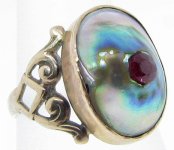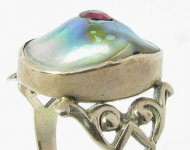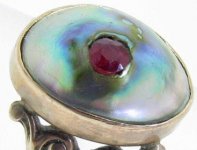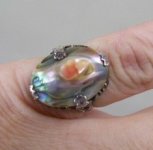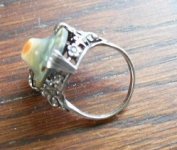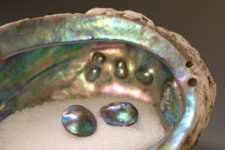You are using an out of date browser. It may not display this or other websites correctly.
You should upgrade or use an alternative browser.
You should upgrade or use an alternative browser.
Abalone Pearls and Mabes
- Thread starter Bodecia
- Start date
I can't make up my mind. Maybe Jeremy or someone will chime in. Boy, you are sure turning into a pearl hunter!!! Your eye is getting very good.
That ruby looks like it is erupting out of the abalone like a pimple!
Hi Caitlin, I do try. Maybe I am slowly getting there
.....................
It looks like shell to me. Are you certain it is abalone? It seems like it was a good thought but ... I wonder how the stone is set in it.
Hi Jeremy,
Not even the seller is calling it Abalone, just pearl. It just looks like Abalone to me. I have a couple of Abalone shells but have only seen the beautiful photos of the real Abalone pearls. At first I thought some idiot had drilled either a pearl or shell to insert the ruby but on looking at the photos enlarged and especially at the one I am including now, I think it may be a natural cavity in either shell or pearl which someone has glued a ruby into. Size 11 x 7 mm. Ruby is .15 carats. Will put in another photo of it where it shows the ruby sticking out of the pearl/shell ..
I could try to find out more but I really doubt that the seller knows anything. Will try though. I wondered if it is worth saving
Bodecia
Attachments
V
Valeria101
Guest
That does look like a butcher's first dabs into jewelry making... but I do like the idea of embedding small precious stones in pearls. Quite allot, actually.
Now, I have not considered cases when perfect, precious pearls may be hacked to insert something... 'guess that's silly. Sometimes, small diamonds are used to plug holes when fully drilled pearls (HERE) and imperfect pearls are sprinkled with tiny stones or other precious 'patches'. I've seen some breathtaking examples I am sure anyone would find easy to love - every time, the design deal with imperfections in the pearl. Now, given cost considerations... maybe some perfectly nice pearls were treated this way at some point - that's anther matter. Dunno ...
...

pearl ring, Michele della Valle
I actually tried on one of these last summer - similar ring, white pearl, same designer. They are spectacular! The pearl was large but quite dull, with dimples remaining on the underside towards the hand. No waste of pearl there. Frankly, I would like something like this made with a better pearl (smaller too. Pearl > finger feels silly) Perhaps soon... if Josh comes around with his offer I'll rid him of a blemished pearl
(smaller too. Pearl > finger feels silly) Perhaps soon... if Josh comes around with his offer I'll rid him of a blemished pearl 
PS. Speaking of hacked pearls... I've got my limits too! What do you make of THIS ?
PPS: how the stones are set? Think 'Epoxi'. And tiny burrs otherwise used for diamond pave. For that, take a look HERE & skip the beading and burnishing steps Now, I'd bet every setter has its own bench secrets and twists of hand. The jeweler where I saw the process in action (and learned a bit too) made his own tools... but the basics remain.
Now, I'd bet every setter has its own bench secrets and twists of hand. The jeweler where I saw the process in action (and learned a bit too) made his own tools... but the basics remain.
When the tiny stones are set in metal (as the half pointers were in the earrings down the link above), the story changes a bunch, of course.
Now, I have not considered cases when perfect, precious pearls may be hacked to insert something... 'guess that's silly. Sometimes, small diamonds are used to plug holes when fully drilled pearls (HERE) and imperfect pearls are sprinkled with tiny stones or other precious 'patches'. I've seen some breathtaking examples I am sure anyone would find easy to love - every time, the design deal with imperfections in the pearl. Now, given cost considerations... maybe some perfectly nice pearls were treated this way at some point - that's anther matter. Dunno

pearl ring, Michele della Valle
I actually tried on one of these last summer - similar ring, white pearl, same designer. They are spectacular! The pearl was large but quite dull, with dimples remaining on the underside towards the hand. No waste of pearl there. Frankly, I would like something like this made with a better pearl
PS. Speaking of hacked pearls... I've got my limits too! What do you make of THIS ?
PPS: how the stones are set? Think 'Epoxi'. And tiny burrs otherwise used for diamond pave. For that, take a look HERE & skip the beading and burnishing steps
When the tiny stones are set in metal (as the half pointers were in the earrings down the link above), the story changes a bunch, of course.
Last edited by a moderator:
V
Valeria101
Guest
Bodecia said:Not even the seller is calling it Abalone, just pearl.
Not sure either; I'd say that the yellow stain there is glue overflow
Overall, this looks more like any other mabe then abalone because of the shape - the dome is too high for abalone mabe which tend to be rather flat.
To me, the seat for the stone appears to have been hacked away with a straight edged something rather then burred... which may account for the bad fit with the outline of the stone
I think I'd like an abalone pearl set with something... perhaps a small colored cabochon... picking the main color of the pearl
That does look like a butcher's first dabs into jewelry making... but I do like the idea of embedding small precious stones in pearls. Quite allot, actually.
Now, I have not considered cases when perfect, precious pearls may be hacked to insert something... 'guess that's silly. Sometimes, small diamonds are used to plug holes when fully drilled pearls (HERE) and imperfect pearls are sprinkled with tiny stones or other precious 'patches'. I've seen some breathtaking examples I am sure anyone would find easy to love - every time, the design deal with imperfections in the pearl. Now, given cost considerations... maybe some perfectly nice pearls were treated this way at some point - that's anther matter. Dunno ...
Hi Valeria101,
Our minds are meshing
Would love to add a sapphire, emerald or even a lowly diamond to a needy pearl. Just to enhance the pearl you realise not to try and take away its own beauty because we all know there is nothing like a pearl and a gemstone can at the most only accent them. Not the other way around.
Looked up the LINK and boy that is horrid. How could a jeweller do that to a perfectly good or not so good pearl. At first I could not work out what I was looking at, until the penny finally dropped that it was a ring - ugg. Yes, we lowly beaders have our standards thank you. Looked up the other link and have bookmarked it so I can ready it later. Very interesting although I doubt I have the tools or know how to do it.
There are many almost perfect pearls out there that are crying out for you to love them and pop a gemstone in its hole or horrid blemish. Go for it. I would if I had your knowledge and abilities and will regardless at sometime or other. Although I could never do it to a perfect pearl and the thing is I even love the blemishes. Have to if you are into Kasumis.
Bodecia
Not sure either; I'd say that the yellow stain there is glue overflow and that the picture was enhanced to exaggerate color saturation - which may account 100% for the violet and blue on the pearl.
Overall, this looks more like any other mabe then abalone because of the shape - the dome is too high for abalone mabe which tend to be rather flat.
Hi Valeria101,
I can't say I absolutely know what an abalone mabe would look like. I thought the pearls of an abalone were in weird and wonderful shapes and sizes. Some of the photos of pieces made up have made me seriously drool. Have no idea what these pieces would cost but I think and arm and a leg.
Then I have seen so called abalone blister pearls being sold and they confuse me no end. I will try to find a photo to go with this post. They are really rather beautiful with a pimple like protrusion which still looks good to me unlike the ruby which does not fit the above ring.
What you refer to as glue overflow looks more like possible peeling to me, but peeling of what? I looked at other photos from that seller and they don't seem to be using any excessive enhanced if at all. Pointed out in another listed how a vintage mabe pearl earrings were dyed which I am confused about because how could they really know if it was vintage and how there was a hairline crack in one pearl that could not be seen with the naked eye. But the two don't gel. The photos can be enlarged to huge and anything can be picked up on.
To me, the seat for the stone appears to have been hacked away with a straight edged something rather then burred... which may account for the bad fit with the outline of the stone No idea why would anyone take such a magnified picture of that job, LOL!
I would like to see photos (prefer the real thing but who am I kidding) of abalone pearls really close up so I could really judge what the edge should look like of a genuine abalone pearl versus abalone shell or anything else. Top grade photos can tell us so much. It just seems strange to me that a dodgey seller would put top grade photos online and try and fudge and lie about a product. Doesn't make sense as you said. The gold on the edge of that "pearl/ruby" ring is horrid on the photo but I bet it is hard to pick up in real life. Still shoddy workmanship but not of the seller's making.
But I truly doubt they have fudged the photo (enhanced). Must ask them. But will I get a reply?
I think I'd like an abalone pearl set with something... perhaps a small colored cabochon... picking the main color of the pearl ... like a drop of water. Some abalone mabes (US produced) are quite inexpensive and would work, methinks.
So would I.
""""
The small whatevers above are where my cat decided to prance across in front of me and ofcourse on my keyboard. Don't they just love to totally delete whatever one has typed, little buggers.
I almost want to buy or bid on the ring to find out what it really is but it is not cheap (and I do like bargains) and then implant a better substitute for the ruby such as another pearl or real pearl so as to cover the imperfection of the dirty great hole in the shell/pearl. If it was or had a good chance of being a genuine Abalone pearl I would lash out and do this but ...... well have to count my pennies, especially since my cell phone was stolen out of my car and I may have to pay hundreds of dollars because of it. ugg. ugg. scream. I didn't realise it had been stolen as I only use it for emergencies - what a bugger.
Please do show us if you decide to inbed a cabochon into a pearl. I for one would love to see it. But do let us know HOW you do it so I can try and follow. Would love to do it and it I do first will post photos, if I do it second I will post photos
Bodecia
V
Valeria101
Guest
Bodecia said:Please do show us if you decide to inbed a cabochon into a pearl. I for one would love to see it. But do let us know HOW you do it so I can try and follow.
I haven't tried that yet, only the little (0.8 to 2.5mm) melee. I don't have access to similar tools to those described in the article either; this is a hobby and I am borrowing bench time from a workshop nearby. Found out rather quickly that drilling precise, shallow pinholes in a soft material is nothing like drilling metal, little wiggle and you've got a crooked, oval seat that's of no use at all. Better have a few pearls to destroy. Can you believe they don't have a pearl drill!? I' wondering now if one of those wouldn't work better, as the machine keep the pearl steady for you.
If I ever get to it again, I'll make sure to post.
V
Valeria101
Guest
As for Abalone mabe, those are the cultured abalone pearls - the only kind so far, full pearls have not yet been produced. The weird shapes are natural abalone parls. And there are natural half-pears too, but also of irregular shapes. The full roundish ones seem to be rather unusual.
I like THIS site for showing how the small, full abalone pearls are formed between layers of thickened shell! The large horn-shaped pearls are a different story (which I never found documented).
Eyris Pearls of New Zealand is the star producer of cultured abalone pearls. There is a thread here with some amazing pictures The website is: http://www.bluepearls.com/
The website is: http://www.bluepearls.com/
Some of the US abalone farms also produce mabes. The quotes for their product are quite modest, I think...
I've tried these: http://www.abpearls.com/
Now, the NZ and US grow different species of abalone: Haliotis Iris and Rufescens, respectively. The colors of the US bunch are more muted, but they are still more colorful then any other pearl... except the other abalone
I like THIS site for showing how the small, full abalone pearls are formed between layers of thickened shell! The large horn-shaped pearls are a different story (which I never found documented).
Eyris Pearls of New Zealand is the star producer of cultured abalone pearls. There is a thread here with some amazing pictures
Some of the US abalone farms also produce mabes. The quotes for their product are quite modest, I think...
I've tried these: http://www.abpearls.com/
Now, the NZ and US grow different species of abalone: Haliotis Iris and Rufescens, respectively. The colors of the US bunch are more muted, but they are still more colorful then any other pearl... except the other abalone
SteveM
Well-known member
- Joined
- Jan 29, 2007
- Messages
- 1,754
A bit of clarification is necessary, as the clusters of pearls within the shell as described on his website by Lou Hill (a gentleman quite willing to communicate with pearl nuts like me/us) are anomalies found on a single beach one Summer that even the late Dr. Graham Brown of Australian Gemmologist was unable to explain, since they were not formed in direct contact with the epithelial cells of the abalone's mantle (can't help but bring to mind prior threads on 'mustika' pearls?). Freeform abalone pearls are created between the mantle and the shell, whereas ab horns, teeth, and other strange and seldom beautiful shapes of potentially huge sizes are formed in the digestive tract and gonad (technically, bezoar stones).I like THIS site for showing how the small, full abalone pearls are formed between layers of thickened shell! The large horn-shaped pearls are a different story (which I never found documented).
Steve
V
Valeria101
Guest
smetzler said:.... anomalies found on a single beach one Summer that even the late Dr. Graham Brown of Australian Gemmologist was unable to explain, since they were not formed in direct contact with the epithelial cells of the abalone's mantle
I am not sure I understand that stumbling block: every layer of the shell would have had contact with the mantle when it was formed...
Last edited by a moderator:
SteveM
Well-known member
- Joined
- Jan 29, 2007
- Messages
- 1,754
The stumbling block here is to assume that these cluster formations observed by one man on one beach during one summer (be they parasitic or cancerous?ozone hole?) are the origin of freeform abalone pearls.I am not sure I understand that stumbling block: every layer of the shell would have had contact with the mantle when it was formed...
V
Valeria101
Guest
The stumbling block here is to assume that these cluster formations observed by one man on one beach during one summer (be they parasitic or cancerous?ozone hole?) are the origin of freeform abalone pearls.
Just one of them... and a very freaky one at that.
I can't imagine anything remotely similar to a pearl sac for those formations!
Would have thought there would be quite a bit of interest in those... but, what do I know...
SteveM
Well-known member
- Joined
- Jan 29, 2007
- Messages
- 1,754
In Dr. Brown's article (as reprinted in 'Pearl World') he did conclude that the clusters are of gemmological interest. However, they were described by Mr. Hill as being quite extensively encrusted in conchiolin, requiring technical and one must assume expensive cleaning, with the end result being tiny individual pearls a fraction of a carat at most, of unproven quality.Would have thought there would be quite a bit of interest in those... but, what do I know...
Thanks for the links Valeria101 and the information smetzler. Found the links and all the informations very interesting.
There is also a so called Abalone blister pearl type often listed on eBay. I will include a photo of one of them. I am presuming that they are some kind of little blister pearl or not coming out of the shell itself. They do rather interest me and I would like to know what they actually are and what causes them to grow like that. Some can look really nice. Some.
I have wondered if the orginal Abalone shell pearl ring that I listed might have actually had one of these blisters on top and it might have been knocked off during wearing. Look at the side view and you can understand why
Thanks all, Bodecia
There is also a so called Abalone blister pearl type often listed on eBay. I will include a photo of one of them. I am presuming that they are some kind of little blister pearl or not coming out of the shell itself. They do rather interest me and I would like to know what they actually are and what causes them to grow like that. Some can look really nice. Some.
I have wondered if the orginal Abalone shell pearl ring that I listed might have actually had one of these blisters on top and it might have been knocked off during wearing. Look at the side view and you can understand why
Thanks all, Bodecia
Attachments
J Marcus
Well-known member
- Joined
- Mar 23, 2008
- Messages
- 376
What it is...
What it is...
I think that I can clear this little mystery up. I've looked at, both inside and out, a few hundred Abalone blister pearls (and this piece in the ring is almost certainly an abalone blister pearl) and have processed a fair number into mabe's. The yellowish line around the red stone (ruby?, garnet?) is the conchiolin layer that is to be found between layers of nacre in a haliotis' shell. Inside of that can be seen the layer below. There is no metal around the stone and it looks like there is a minuscus of what is probably a glue around the very edge. Most, though not all, natural abalone blister pearls tend to be quite thin on top with only from 1 to a few layers of nacre and those often very thin. If the blister pearl has not been filled with a polymer and converted to a proper mabe' then it may have been very fragile at the point that the stone has been placed. It is possible, though I can't tell for sure, that the blister pearl may have suffered damage at that point and the stone may have been glued in to fill the void. I would call that best case.
I have a few abalone blister pearls that are beautiful except that they have a hole through the nacre of the blister or near it. I am planning to inlay gems, properly set in gold, into these. I'm not sure what this does to the value of such a pearl, but without this or a similar repair/enhancement, they probably have very little value and it seems a shame to discard such an object of beauty. When I am able to do this, I will post photo's to this forum.
I have seen quite a number of the pieces like the one Bodecia posted just before me. They all appear to be of a "certain age" and seem to be something that was popular sometime in the first half of the 20th century. It is my opinion that these most certainly are not blister pearls. The red, high center of these gems is the colored outside layers of a Haliotis Rufrescens, Corrugatta, Wallalensis (not sure of the spelling) or similar abalone and I know of no blister pearl that has formed on the outside of a shell--it's probably a biological impossibility. It was carved into this form from a piece of shell.
Regards,
J Marcus
http://www.flyrodjewelry.com/about_abalonemabes.html
What it is...
I think that I can clear this little mystery up. I've looked at, both inside and out, a few hundred Abalone blister pearls (and this piece in the ring is almost certainly an abalone blister pearl) and have processed a fair number into mabe's. The yellowish line around the red stone (ruby?, garnet?) is the conchiolin layer that is to be found between layers of nacre in a haliotis' shell. Inside of that can be seen the layer below. There is no metal around the stone and it looks like there is a minuscus of what is probably a glue around the very edge. Most, though not all, natural abalone blister pearls tend to be quite thin on top with only from 1 to a few layers of nacre and those often very thin. If the blister pearl has not been filled with a polymer and converted to a proper mabe' then it may have been very fragile at the point that the stone has been placed. It is possible, though I can't tell for sure, that the blister pearl may have suffered damage at that point and the stone may have been glued in to fill the void. I would call that best case.
I have a few abalone blister pearls that are beautiful except that they have a hole through the nacre of the blister or near it. I am planning to inlay gems, properly set in gold, into these. I'm not sure what this does to the value of such a pearl, but without this or a similar repair/enhancement, they probably have very little value and it seems a shame to discard such an object of beauty. When I am able to do this, I will post photo's to this forum.
I have seen quite a number of the pieces like the one Bodecia posted just before me. They all appear to be of a "certain age" and seem to be something that was popular sometime in the first half of the 20th century. It is my opinion that these most certainly are not blister pearls. The red, high center of these gems is the colored outside layers of a Haliotis Rufrescens, Corrugatta, Wallalensis (not sure of the spelling) or similar abalone and I know of no blister pearl that has formed on the outside of a shell--it's probably a biological impossibility. It was carved into this form from a piece of shell.
Regards,
J Marcus
http://www.flyrodjewelry.com/about_abalonemabes.html
Last edited:
J
jerin
Guest
Hi J Marcus and welcome to our forum!
Thanks for a very interesting article on Abalone blisters and Mab?s. We look forward to more posts and photos!
Thanks for a very interesting article on Abalone blisters and Mab?s. We look forward to more posts and photos!
J
jerin
Guest
Hi and welcome to the forum, Hopepaua.
Lovely picture of a lo vely Oyster with "blister-children".
vely Oyster with "blister-children".
Lovely picture of a lo
Similar threads
- Replies
- 2
- Views
- 628
- Replies
- 17
- Views
- 669
- Replies
- 1
- Views
- 747

